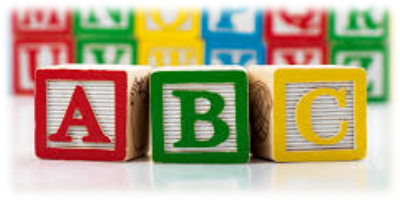In my 20 year-project on words, I am confirming that sound is sense, and that human vocabulary (all variants of the original Edenic - Hebrew plus proto-Semitic roots) is from the same creator of physics and chemistry. I was taught otherwise in graduate English studies, that words derived from the evolved grunting of cavemen. I did learn that all spelling is a late and arbitrary convention, although most skeptics and agnostics seem to think that dictionaries were carved in stone and any creative variations are a sacrilege.
My thesis is as old as Genesis 11, yet my work remains radical (pun intended). As a root doctor, I seek sub-roots, and follow the shifts in sound and space of each root letter. I mostly listen to phonemes, the sound of two root letters combined. Anything longer than two letters is a combination of meaning elements, just as anything including H2O has been added to water. I have not done much with the history or shape of the Torah's alphabet/Aleph-Bet. There are books on the mystical symbolism and meaning of each letter, and I defer and refer you to them. They are largely homiletic, symbolic, or kabalistic. I have been challenged to consider questions about the origin of writing and of the design of the Torah's Aleph-Bet from a more scientific perspective.
The earliest Hebrews spoke Hebrew, but we may never know if the patriarchs had the Torah's Aleph-Bet, which bears little resemblance to the ancient hieroglyph alphabets of the Middle East. The Semitic 8th Century B.C. alphabet is far more evident in the English and Greek alphabets (the Z or L is identical), while sometimes the glyph must be rotated (the glyph for an ox or aleph is an A fallen to the left). These Aleph-bets were so common that most (non-clerical)Israelites used the wavy line of mayim (water) seen in the English letter M. That the hieroglyphic letters did not evolve to the Torah letters is evident, for example, from the ancient B (the English b turned on its head) not resembling the Bet. The Ktav Ashurit of the Torah was only standardized by Ezra in the 2nd Temple period, when the Semitic aleph-bet was in decline and Hebrew might otherwise be recorded in Greek letters. Non-scribes would have surely forgotten the sacred Aleph-bet, as happened to venerable alphabets in India and Japan.
Unique among ancient writing systems, the Torah's Aleph-Bet, or Ktav Ashurit, depicts the shape of the human mouth and air flow necessary to pronounce each letter.
Bet, like Pey, is a graphic of the human lips, or what linguists call a bilabial plosive. What is the only difference between the similar looking Bet and Pay?
The Pay indicates muscular stress on the upper lip - precisely that which differentiates a P sound from a B. Mem and Nun in Ktav Ashurit are not graphics snakes or water. They do both have the backward L graphic of a nose. (O.K., not a little Dutch nose; we are talking Semitic.) If these two nasals (in linguistics) are noses, why is there the whole C-like or Bet-like structure to the right of the Mem? Unlike N, one needs a closed mouth behind the nasal to make the M sound. M is a nasal, but it also uses the nearly closed lips.
Liquids (L and R) are interchangeable in linguistics (ask any Asian), and so the Lamed and Resh nearly look alike. Both letters show the tongue curled upward in an open mouth. The crucial difference between them is the Lamed's upward extension, indicating the tip-of-tongue stress on the roof of the mouth. Daled and Tet are another good pair, of interchangeable sounds called Dentals. In both the tongue is stiffly vertical to the teeth ridge. The difference between D and T is the solid engagement of the top, indicated by the Daled's T-like axis, and the slight gap and quicker, lighter engagement of the teeth ridge by the (ironically) D-like Tet.
Gutturals Het, Kof and Kuf indicate air being forced out harshly. The Hey and Het are most identical and are easiest to sound out the difference between a similar sound with air expelled openly and with ease or closed to make that guttural noise. Pull the leg of the Hey and you get a Kuf. Go deeper in the throat to pronounce the deeper guttural. What about the whistling sibilants like Zayin, Samech and Shin? The tongue is positioned for Zayin almost like a Dalet; the two similar letters are linked in some languages, so that AUDIENCE , an ADN term, came from AZN, OzeN,the Hebrew ear. The tongue closes a circle for the Samech, while air streams out from both sides of the upraised tongue for the Shin and Sin. Thus the graphic resembling two air streams split by the upraised tongue in the middle of the mouth.
The unique alphabet that diagrams the movements in the human mouth spells out words in the one language where synonyms and antonyms sound alike because they were engineered as matter and anti-matter. (A poor strategy for words to evolve by humans for mere semantic utility.) For example: While Samech-Vav-Resh , SVR, SooR means to stray from the straight and narrow (source of SWERVE), Shin-Vav-Resh-Hey, SH-V-R-H, ShooRaH means a row or straight line (source of SERIES). Like-sounding synonyms include YaSHaR, straight (source of SHEER).
Once a two-letter root or phoneme is isolated with a meaning, one can even play with the sub-root on the Aleph-bet keyboard. For example, Bet-Lamed meansintertwined, as in BaLaL (to mix or BALL up), Babel and BABBLE. Let's build on BL, just as one can make water by adding oxygen atoms to hydrogen. We'll go up the piano scale of intensity as we add gutturals to Bet-Lamed. (1) GeBHel is a plait or braid, (2) HeBHeL is a string or rope, and (3) KeBHeL is a very strong rope or cable (Yes, of course it's the source of CABLE). We went up the keyboard of gutterals, Gimmel to Khet to Khuf, just as we intensified the interweaving threads of the semantics.
Granted, then, Hebrew may be the most venerable and unique language we currently know, and, together with data showing how it links to all human vocabularies better that Indo-European roots, Nostratic or other laboratory concoctions, it may be a leading candidate for the language of creation. Even if one speculates that Adam and Eve were programmed with Hebrew as their computing language, and that this Urshprache got scrambled into superfamilies in a Big Bang at Babel (which de-evolved over the millennia to thousands of dialects), how did the first Hebrew get Hebrew? Was not the language of Eden and the Aleph-Bet lost in the mixing BOWL (another BL term of confusion)? In fact, isn't it true that Abraham's family spoke a Mesopotamian language that was not Hebrew? These are good questions that I have been forced to ponder.
I will dispense with legends about angels teaching Abraham Hebrew, and presume that the Hebrews were literate well before phrases were carved in stone for them at Sinai. Joseph, for instance, was invaluable to his bosses for the same reason that Jews were the accountants of pre-Europe Europe. They had the magic of counting and spelling in letters. Only Hebrew has letters that are numbers. PhDs in Biblical literature who are unfamiliar with the numerical values of key phrases are only skimming the surface of the Hebrew text. That's why a shpiel, even a good shpiel like the Go-SPELL, is from SaPHeR (to count). That's why an accounting (retelling) is like counting. Perhaps literacy knew the first Cro-Magnon from Adam. My data shows that Adam's names for even distant animals seem to have stuck. (SKUNK only means stinker in Hebrew; many more at my web site.) The first language and perhaps this biologically correct alphabet should have made it to the deluge.
The flood survivors were not likely to forget their language, and may even have had some writings equivalent to the alphabet-learning cuneiform shards found in the ancient Near East. It is conjectured that Shem (the first Semite) taught the antediluvian language to Abraham. They shared fifty years of life, and I visited the Galilee cave where this learning is thought to have taken place. Abraham did not need to learn just any language, but he might be taught readin', writin' and 'rithmatic with the Ktav Ashurit if it were something special and worth preserving.
It would not matter if carbon 14 dating of Sumerian shards are earlier than Abraham's Late Bronze Age. Hieroglyphic systems are certainly older than any widespread use of Ktav Ashurit, but it may be that the Aleph-Bet was quietly passed down the generations, from Adam to Shem, from Abraham to a baby crying in a Tel Aviv street. The proof is in the pudding. There is far too much intelligent architectonics in Hebrew and its Aleph-Bet for it to produced by humans. If one is uncomfortable with the concept of a superhuman who created Mother Nature, this natural alphabet and language, then at least consider an extraterrestrial designer. I suspect that those who still believe that language is the evolved grunting of cavemen may need to step out into the light and study the topic a bit deeper.
Like what you’re discovering? Continue the journey from Bible reader to translator.
|






